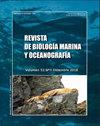墨西哥湾So Veracruzano渔场系统中Belzebub faxoni(十足目,萤火虫科)的分布、密度、性别比例和生育率
IF 0.5
4区 生物学
Q4 MARINE & FRESHWATER BIOLOGY
引用次数: 4
摘要
西班牙分析了墨西哥湾西南部Arrecifal Veracruzano系统国家公园(PNSAV)中B.faxoni的分布、密度、生物量、性比和生育率。生物样本收集于2011年6月、8月和10月进行;2012年1月、3月和5月以及2013年1月、3月和6月。为了收集,使用330µm孔径的锥形网络,从一艘装有舷外发动机的快艇在水面上进行了拖网。测量盐度、温度和氧气。计算虾的总数,并将其标准化为100 m-3。测量了大小和生物量。计算了每只孕妇的卵子数量。分析了其分布和密度。3年采样期间的参数值在温度21.95±0.11至29.29±0.19°C、盐度33.91±0.10至35.90±0.14和氧气2.45±0.23至5.63±0.61 mg L-1之间。密度最高的是2013年3月,有6391只虾100立方米。总体而言,密度最高的是B和D断面(PNSAV的中部和南部)。2013年3月,我的生物量最大,为5283毫克100立方米。总长度为12.28±0.59毫米的雌性的生育率为7.1±3.43个卵。分析了墨西哥湾西南部韦拉克鲁斯珊瑚礁系统国家公园贝尔泽布·法克奥尼的分布、密度、生物量、性别比和生育率。2011年6月、8月和10月,在一艘装有舷外发动机的摩托艇上收集了生物样本;2012年1月、3月和5月;2013年1月、3月和6月,使用330µm的圆锥网。测量了盐度、温度和氧气。虾的总数被统计和标准化为100 m-3。测量了生物量和高度。计算了每个孕妇的鸡蛋数量。分析了其分布和密度。平均气温为21.95±0.11至29.29±0.19°C,盐度为33.91±0.10至35.90±0.14,北部为氧气2.45±0.23,南部为5.63±0.61 mg L-1。密度最高的是2013年3月,有6391只虾/100立方米。一般来说,密度最高的是B和D断面(中部和南部)。2013年3月,它的生物量最高,为5283毫克100立方米。总长度为12.28±0.59毫米的雌性生殖率为7.1±3.43个卵。本文章由计算机程序翻译,如有差异,请以英文原文为准。
Distribución, densidad, proporción sexual y fecundidad de Belzebub faxoni (Decapoda, Luciferidae) en el Sistema Arrecifal Veracruzano, SO del Golfo de México
espanolSe analizo la distribucion, densidad, biomasa, proporcion sexual y fecundidad de B. faxoni en el Parque Nacional Sistema Arrecifal Veracruzano (PNSAV), suroeste del Golfo de Mexico. La recoleccion de las muestras biologicas se realizo en junio, agosto y octubre 2011; enero, marzo y mayo 2012 y enero, marzo y junio 2013. Para la recolecta se efectuaron arrastres en el nivel superficial del agua desde una lancha con motor fuera de borda, utilizando una red conica de 330 µm de abertura de malla. Se midio la salinidad, temperatura y oxigeno. Se contabilizo el numero total de camarones y se estandarizo a 100 m-3. Se midio la talla y la biomasa. Se conto el numero de huevos de cada hembra gravida. Se analizo la distribucion y densidad. Los valores de los parametros durante los 3 anos de muestreo oscilaron entre 21,95 ± 0,11 a 29,29 ± 0,19 °C de temperatura, 33,91 ± 0,10 a 35,90 ± 0,14 de salinidad y 2,45 ± 0,23 a 5,63 ± 0,61 mg l-1 de oxigeno. La mayor densidad se presento en marzo 2013 con 6.391 camarones 100 m-³. De manera general la mayor densidad se presento en los transectos B y D (centro y sur del PNSAV). Marzo 2013 presento la mayor biomasa con 5.283 mg 100 m-³. Las hembras con longitud total de 12,28 ± 0,59 mm presentaron una fecundidad de 7,1 ± 3,43 huevos. EnglishThe distribution, density, biomass, sex ratio and fecundity of Belzebub faxoni in the Veracruz Reef System National Park, southwest of the Gulf of Mexico, were analysed. The collection of biological samples was conducted on a motorboat with outboard motor in June, August and October 2011; January, March and May 2012; and January, March and June 2013, using a conical net of 330 µm. Salinity, temperature and oxygen were measured. The total number of shrimps were counted and standardized at 100 m-3. The biomass and height were measured. The number of eggs of each gravid female was counted. The distribution and density was analysed. The average temperature was 21.95 ± 0.11 to 29.29 ± 0.19°C, salinity of 33.91 ± 0.10 to 35.90 ± 0.14, oxygen 2.45 ± 0.23 in the northern zone and 5.63 ± 0.61 mg l-1 in the south. The highest density was presented in March 2013, with 6,391 shrimp/100 m-³. Generally, the highest density was presented in transects B and D (centre and south). March 2013 had the highest biomass with 5,283 mg 100 m-³. Females with a total length of 12.28 ± 0.59 mm had a fertility rate of 7.1 ± 3.43 eggs.
求助全文
通过发布文献求助,成功后即可免费获取论文全文。
去求助
来源期刊
CiteScore
0.70
自引率
0.00%
发文量
41
审稿时长
12 months
期刊介绍:
Publicar desde una perspectiva científica, artículos originales, decididos por un proceso de revisión por pares, invitando a expertos de reconocido prestigio en el área. Los trabajos publicados se caracterizarán por su solidez teórica-metodológica, actualidad y relevancia para las ciencias marinas.
Se reciben trabajos inéditos derivados de la investigación científica realizada en ambientes marinos y estuarios, en formato de Revisión, Artículos, Notas Científicas, y Obituarios en las siguientes disciplinas::
Biología-Ecología marina
Oceanografía física, química y biológica
Contaminación marina
Geología marina
Sistemática, Faunística y Biogeografía Marina
Manejo Costero
Acuicultura marina
Pesquería marina.

 求助内容:
求助内容: 应助结果提醒方式:
应助结果提醒方式:


